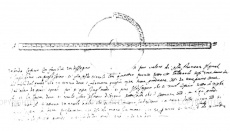Instrument for Copying Drawings
From Inventions
(Difference between revisions)
| (One intermediate revision not shown) | |||
| Line 17: | Line 17: | ||
|immagini= | |immagini= | ||
| + | |||
| + | <gallery widths=230 heights=368 perrow=3> | ||
| + | |||
| + | Image: 56712.jpg | Giacomo Contarini. ''Figure d'Istromenti Matematici'', Oxford, c. 1590, c14parziale.<br /> | ||
| + | |||
| + | </gallery> | ||
| + | |||
| + | |||
|autore_scheda= Filippo Camerota | |autore_scheda= Filippo Camerota | ||
Current revision as of 08:35, 10 September 2010
Has no specific name.
Contents |
Historic Period
XVI century
Description
Illustrated in a manuscript by Giacomo Contarini, the instrument is composed of a goniometer with a graduated ruler pivoting at its centre. The goniometric circle had four points used to fix it to the drawing board. The ruler had symmetrical graduation, so that each point measured on the drawing placed beside the goniometer could be transcribed onto the blank sheet of paper placed on the opposite side. To enlarge or reduce a drawing, it was sufficient to multiply or reduce the measurements.
Bibliographical Resources
Contarini, Giacomo. Figure d’istromenti matematici e loro uso , ca. 1590. Oxford, Bodleian Library, Ms. Canon. Ital., 145, c. 40.
Images
Author of the entry: Filippo Camerota

